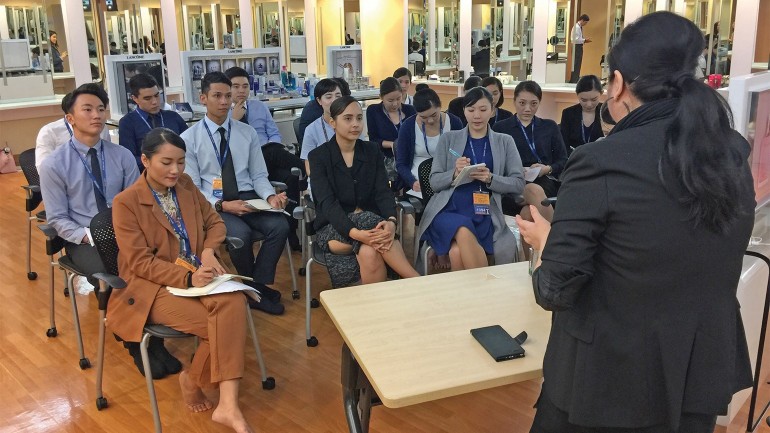Sponsored Listings:
SINGAPORE — On a Thursday at the Singapore Airlines training center, not far from this city-state’s Changi Airport, the company’s vice president of public affairs, Nick Ionides, had a message for me and two other journalists as we began our private tour of the facility.
“You are in the most polite building in all of Singapore. It’s the first thing I want to tell you,” Ionides said.
Sure enough, moments later, as we encountered our first group of trainees, a class of approximately 20 new hires, they stopped in unison and took quick direction from their instructor.
“Good afternoon, Mr. Nick,” they said all together, with near military precision.
Singapore Airlines enjoys an exceptional worldwide reputation for service and has won Conde Nast Traveler’s Readers’ Choice Award for best global airline in 28 out of the last 29 years, including the 2016 award last month.

Indeed, while the days when the U.S. airline industry was seen as sexy and glamorous are mainly just a memory relived in movies and on television, Singapore Airlines continues to carry such a banner.
Ionides said that when the carrier does hiring calls for flight attendants, it typically draws some 1,000 people, hiring about 10% of the applicants. Those who are selected are almost all — to a man and woman — young, thin and good-looking. Or at least that’s what I observed in the training academy and on my Singapore Airline flights to and from San Francisco last month.
Even Singaporeans who aren’t associated with it told me that the airline is a source of pride for this country of approximately 5.7 million.
During my two-hour tour through the training academy, I learned that such acclaim isn’t won haphazardly. The sprawling facility is filled with mock-ups of various types of aircraft flown by Singapore Airlines. The models are tailored to mimic the carrier’s actual cabin configurations so that aspiring flight attendants can train in the precise environment in which they will ultimately work.

For safety training, incoming flight attendants, as well as longtime employees in for a refresher, make use of evacuation slides that are exactly as high as the doorway of a Boeing 777 and the second level of a jumbo Airbus A380, respectively.
Similarly, trainees learn about water rescues by jumping out of a model aircraft into a large wave pool, then swimming to a nearby flotation raft.
The trainees also undergo detailed lessons on hygiene and etiquette as part of the 15-week course, which Ionides said is approximately double the industry standard.
Though I’ve rarely been accused of being debonair, it was the hygiene lesson that was probably my favorite part of the tour.
The airline has several rules regulating the way flight attendants must present themselves. Women, for example, must either keep their hair shorter than shoulder length or wear it in a bun, and they can wear only brown or blue eye shadow. Men must part their hair at 45 degrees to the left or right, their hairline can’t touch their ears, and though a mustache is allowed it can’t conceal the shape of one’s lips.
As I stood in on a hygiene lesson, instructor Amy Lim told a class of cadets that it is important to stay well hydrated in order to keep the skin from breaking out.
“Drink eight glasses of water per day, but don’t drink too much before you sleep when you have a morning flight,” she said. “Otherwise, you’ll get puffy eyes.”
Lim had equally detailed advice on eating habits.
“Stay away from food that is cooked with herbs or spices, because too much of that will make your body smell very sophisticated,” she deadpanned to nodding heads.
Nearby, Singapore Airlines flight attendants were in a different section of the training facility, brushing up on their emergency evacuation training.
I watched — feeling a bit envious, actually — as the trainees went one after another down the evacuation slide of a model aircraft that simulated the height of a 777.
Some went quickly, clearly enjoying the experience, while others hesitated at the top before eventually taking the slide amid encouragement from their colleagues below.
Watching the trainees in cabin-service dry runs also proved to be an interesting exercise.

“Hurry up, this plane needs to go to San Francisco,” trainer Muhd Hafiz barked at a class of 17 as they practiced turning over the economy section of a Boeing 777 after landing.
Earlier, the trainees, who were just one week away from working their first flights as apprentice attendants, had practiced and been drilled on pre-flight safety and service protocols.
“Can passengers be connected to their iPad?” Hafiz asked.
“No,” came an answer.
“Why?” he followed up.
“Because there is potential to spark,” a cadet said.
As I ended my tour, I couldn’t help but think that the careful manner in which Singapore Airlines trains its cabin crew is surely a key reason why it has achieved so much international acclaim.
But Ionides said that the carrier’s cabin service success starts with the hiring process.
“The first thing you are looking for is someone who has a desire to please a customer,” he said.
Sourse: travelweekly.com










